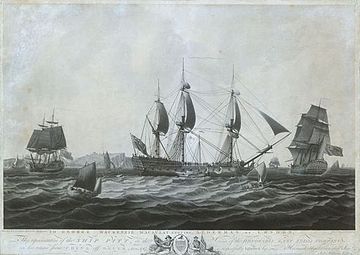 Pitt, near Dover returning from China 1787; National Maritime Museum, Greewich, and based on a painting by Dominic Serres, National Maritime Museum, Greewich
| |
| History | |
|---|---|
| Name | Fortitude |
| Owner | Jeffery Jackson[1] |
| Builder | Wells, Deptford[1] |
| Launched | 1780[2] |
| Captured | 23 June 1782 |
| Acquired | 1782 by capture |
| Fate | Sold |
| Name | Fortitude |
| Owner | East India Company |
| Acquired | By purchase |
| Fate | Sold 1785 |
| Namesake | William Pitt the Elder |
| Owner | |
| Acquired | 29 October 1785 by purchase |
| Renamed | Pitt (1785) |
| Fate | Sold 1798 |
| Name | Pitt |
| Owner | Wildman & Co. |
| Acquired | 1798 by purchase |
| Fate | Sold for breaking up 1801 |
| General characteristics [4] | |
| Tons burthen | 761,[5] or 775,[4] or 77568⁄94[1] (bm) |
| Length |
|
| Beam | 36 ft 1+1⁄2 in (11.0 m) |
| Depth of hold | 14 ft 9+1⁄2 in (4.5 m) |
| Complement |
|
| Armament | |
Fortitude was a merchant vessel built in 1780 on the River Thames. A French frigate captured her in 1782 while she was on the return leg of her maiden voyage to India as an East Indiaman for the British East India Company (EIC). However, the British recaptured her in October 1782. The EIC purchased her and sent her back to England. There, in 1785, George Macartney Macauley purchased her and renamed her Pitt. She then performed five voyages for the British East India Company (EIC) between 1786 and 1798. In between, she made one journey transporting convicts from England to New South Wales. She was broken up in 1801.
- ^ a b c Hackman (2001), p. 110.
- ^ Lloyd's Register (1787).
- ^ a b British Library: Pitt (2).
- ^ a b British Library: Fortitude (1).
- ^ a b c d "Register of Letters of Marque against France 1793-1815"; p.81 Archived 9 July 2015 at the Wayback Machine